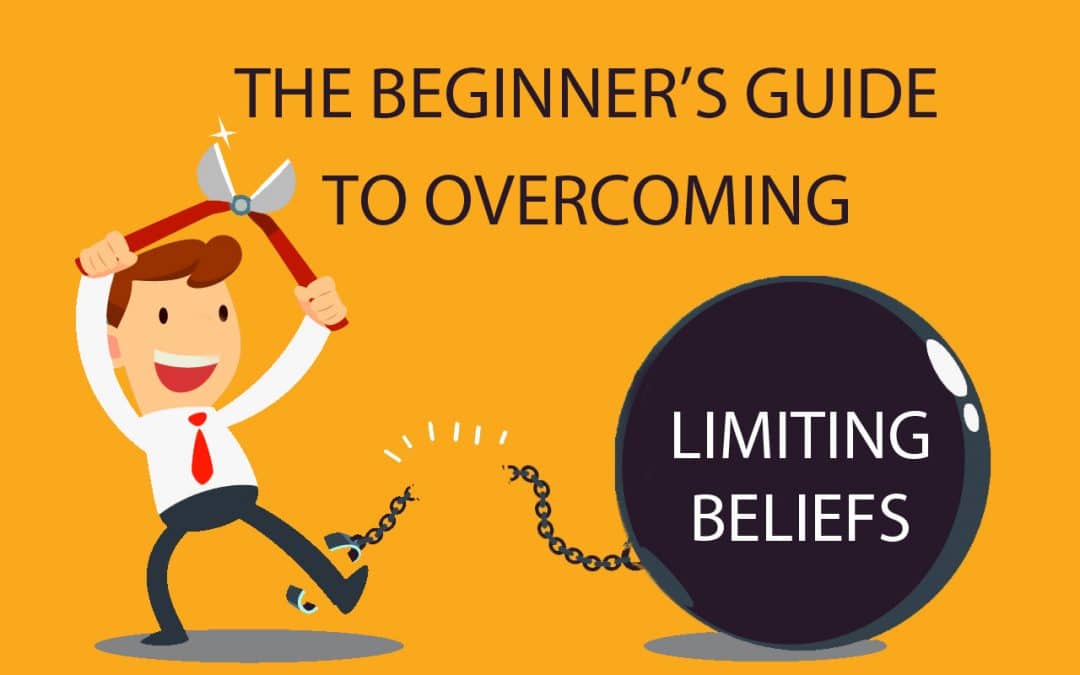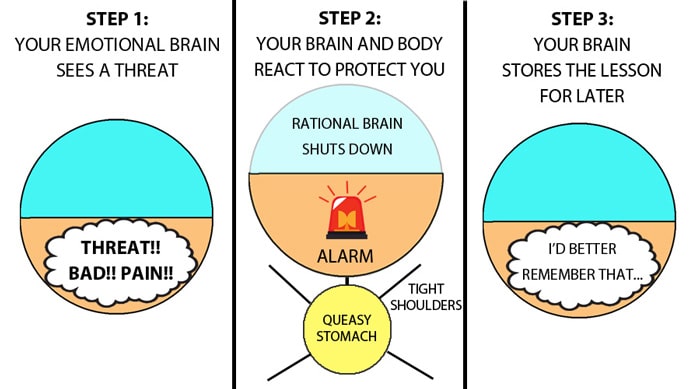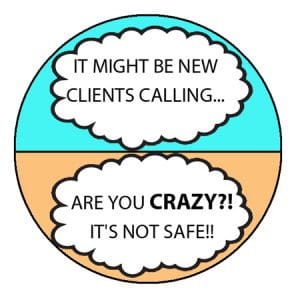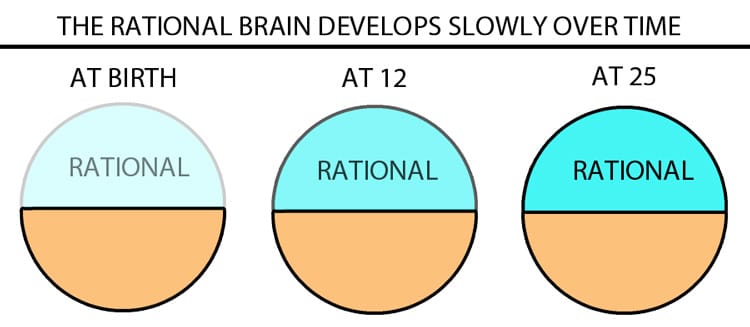Do you ever feel frustrated about reaching your potential?
Like there’s an invisible wall holding you back?
If so, you may be suffering from a limiting belief.
But here’s the good news: You don’t have to live with your limiting beliefs forever.
New brain research has shown us how to delete and re-write the old, negative beliefs that keep us stuck.
In this Beginner’s Guide, we’re going to show you the steps to identify and change your limiting beliefs.
We’ve broken down this guide into two parts:
Part 1: Six Brain Rules That Explain How Hidden “Sabotage Bombs” Get Planted in Your Psyche
Part 1 is what you’re reading now. It will explain what limiting beliefs are and where they come from.
You’ll also learn about 6 key “Brain rules” of the Emotional Brain.
This is the part of your mind that creates and stores your limiting beliefs.
It’s helpful for you to understand these brain rules so you can overcome your limiting beliefs for good.
Part 2: Overcoming Your Limiting Beliefs in 3 Simple Steps
In part two, we’ll share a simple process for overcoming most limiting beliefs.
We’ll also walk you through a couple of examples of how to use the process.
The Curious Case of Night-time Insomnia
 It was 2 am and Josh couldn’t fall sleep…
It was 2 am and Josh couldn’t fall sleep…
Earlier that day, a new coaching client had signed up to work with the Learn Your Brain team.
As soon as they had signed on the dotted line, Josh felt the predictable freak out feeling inside.
He felt unsettled and anxious. It was hard to focus on work the rest of the afternoon.
His mind kept jumping back to the new client. He thought of all the things that needed to get done before the coaching program started.
By the time he got to bed, the anxiety had grown to a full-blown explosion inside.
He lay awake for hours, just like other nights when they started working with a new client. Try as he might, he couldn’t shut his mind off and get the rest he so desperately needed.
Josh was really angry at himself for allowing his mind to get the best of him again.
What the heck was wrong with him?
What he didn’t know at the time was that he was about to make a discovery that would change his life forever…
So, what is a limiting belief anyways?
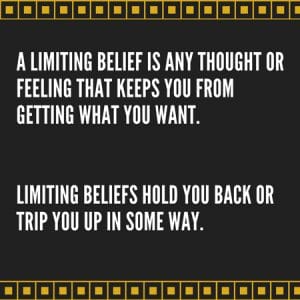 You’ve got to know what you’re dealing with if you want to change a limiting belief.
You’ve got to know what you’re dealing with if you want to change a limiting belief.
In a second, we’ll explain what’s happening inside your brain when you have a limiting belief.
But for now, here’s our broad definition:
A limiting belief is any thought or feeling that keeps you from getting what you want. Limiting beliefs hold you back or trip you up in some way.
As you’ll see in a second, it’s not really the belief itself that holds you back.
It’s the fear response in your brain and body that makes these suckers so hard to deal with.
Limiting beliefs ALWAYS go hand in hand with feelings. They either cause some kind of pain in your life right now, or they’re trying to keep you from feeling pain.
How do you know you have a limiting belief?
The tricky part of changing limiting beliefs is that most of them are subconscious. You usually don’t know what they are about.
They are the “invisible wall” or “invisible land mines” that we keep running into.
In Josh’s example, he didn’t know why he was freaking out so much every time a new client signed up to work with him.
He couldn’t put his finger on the actual belief that was causing his anxiety.
This is a common issue with limiting beliefs – we often don’t know where they come from or why we’ve got them.
Luckily, there are three ways to know if you have one:
- You have behavior or results you don’t like
- You have a repeated pattern of negative feelings
- You notice that your self-talk is negative
Let’s look at each one a little more…
You have behavior/results you don’t like
Are there areas in your life where you’re not producing the results you want?
Do you know you need to do something to be successful, but you avoid doing it?
Do you procrastinate, or sabotage yourself over and over again?
Here are some examples of observing your behavior or results:
- You avoid calling prospects to grow your business
- You procrastinate on a task you know you should do
- You sabotage relationships with others
- You have a hard time saying “No” and putting boundaries around your time.
We’ve coached plenty of people who KNOW that they need to reach out to new prospects to grow their business.
But day after day, they find themselves avoiding picking up the phone.
In their brain, they’ve linked some kind of pain to calling on new prospects.
So it makes perfect sense that they hesitate to call.
Do you sabotage yourself in some way, like our friend Sam?
Sam sabotages himself on an almost daily basis.
He often has a huge pile of work and a tight deadline to meet.
But he finds it impossible to tell his friends “No” when they invite him to lunch.
Every day.
So the work keeps piling up, and his stress level does too. But it doesn’t stop him from saying “Yes” to his friends again and again.
The number of ways we can sabotage ourselves as human beings is truly limitless.
But a limiting belief is always the reason.
Let’s look at the second way to know if you have a limiting belief:
You have a repeated pattern of negative feelings
 Here’s the second way to know you have a limiting belief: You have a repeated pattern of negative feelings.
Here’s the second way to know you have a limiting belief: You have a repeated pattern of negative feelings.
Unlike the first category, this is about noticing how you feel.
If any of these statements apply to you, you’ve probably got a limiting belief hidden in the shadows:
- You feel anxious in specific situations (networking, meeting new people, etc.)
- You’re anxious about certain activities (public speaking, selling, etc.)
- You have a general sense of anxiety that you can’t shake
- You struggle with a poor self-image or poor self-esteem
- You have emotional reactions or outbursts that are bigger than the situation warrants
- You lack confidence in yourself in a particular area of your life (or you lack confidence in general)
- And so on…
For example, let’s talk about public speaking, a common fear that provokes extreme anxiety.
Did you know that some of us are more afraid of public speaking than of dying?
The thought of speaking in front of a group of people can make your knees weak and sweat pour off your face.
This fear can be so strong that some people turn down better jobs just so they don’t have to give presentations.
That shows the power of limiting beliefs to stop you in your tracks.
You notice that your self-talk is negative
 The third way to know if you have a limiting belief is to listen to the voice in your head.
The third way to know if you have a limiting belief is to listen to the voice in your head.
We all have an internal voice that is providing constant commentary on our day.
Do you notice when that voice in your head is harsh, judgmental, or negative? That’s a good sign that a limiting belief is lurking.
Here are some signs you have limiting beliefs wreaking havoc inside your head:
- You’re hard on yourself when things don’t go according to plan.
- You believe that noticing all your mistakes and faults is the path to improving yourself.
- You have a great story about why you’re not as successful as you want to be. (“I’m not smart enough/attractive enough/rich enough/young enough, etc.”)
- Your mind easily jumps to the negative side or the danger of any situation.
But there’s good news: there’s a way out of the struggle!
You can overcome any limiting beliefs if you know how your “Emotional Brain” works.
This next section explains it all…
Introducing Your Two Brain Systems (Rational and Emotional)
Most approaches to changing limiting beliefs don’t work. Or they take a long time to help you feel better.
That’s because these approaches have a big flaw… they’re trying to change the wrong part of your brain!
Let us explain…
You have two different systems in your mind. We’ll call them the Rational mind and the Emotional mind.
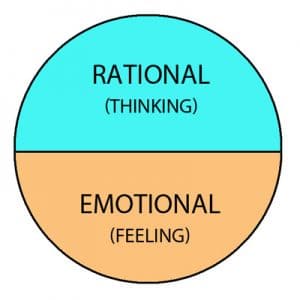 **(In reality, your mind and brain are very complex. But since this is the beginner’s guide, we’re going to make things much simpler for you. You don’t have to know all the ins and outs of the brain to change limiting beliefs.)
**(In reality, your mind and brain are very complex. But since this is the beginner’s guide, we’re going to make things much simpler for you. You don’t have to know all the ins and outs of the brain to change limiting beliefs.)
Some people call these different parts the Conscious and the Subconscious.
Another way to describe them is the Thinking and Feeling mind.
For the rest of this guide, we’re going to use the terms “Rational/Emotional brain.”
This video explains these two parts of your mind in more depth: (Click the gear icon and select “High Definition” for the best quality)
As you can see from this video, it’s the Emotional Brain that creates and stores our limiting beliefs.
So if you want to free from a limiting belief forever… you have to change the programming in your Emotional Brain!
These six brain rules will help you understand how this part of your mind “thinks” and how it sees the world.
Brain rule #1: The Emotional Brain’s #1 job is to help you survive, not thrive
Every other brain rule comes out of this first rule, so it’s super important to understand.
The Emotional Brain is not wired to help us reach our huge potential as human beings. It’s wired to keep us safe and to help us stay alive.
And it’s really good at that task.
People who study the brain explain that our brains have a built-in “negativity bias.”
Here’s what the negativity bias means in simple terms:
Your brain focuses on and remembers negative experiences much more than positive ones.
Why? The brain sees negative experiences as threats that need to be dealt with.
Positive experiences, while pleasant, just aren’t that urgent. When something good happens, it’s obviously not a threat to you.
The Emotional Brain’s number one tool for keeping you alive is the “Threat Response.” It’s also known as the “Fight, Flight, Freeze” response.
Here’s the gist of how it works:
Remember Josh’s story about how he couldn’t fall asleep?
He would lie in bed at night, desperately trying to go to sleep. But his mind spun frantically. He was trying to plan stuff that was way out in the future, most of which he couldn’t control.
And his body was wound up with tension…neck and shoulders tight like an iron rod. A swirling hurricane of anxiety raged through his chest.
 These were all signs of the threat response rampaging through his mind and body.
These were all signs of the threat response rampaging through his mind and body.
He felt in danger. Something about bringing on a new client threatened him. His mind and body were screaming at him, “Stop!! You can’t go to sleep! Deal with this!”
Even though he didn’t know what the “this” was.
Now, Josh’s Rational Brain knew how wrecked he would be if he didn’t sleep. He knew his performance would be crap the next day.
Knowing this still wasn’t enough to stop the storm. There was no way he could stop his Emotional Brain’s intense reaction.
The Threat Response is a miracle of evolution. It’s amazing at keeping us alive and safe from physical threats so we can live a long life.
But there’s one big problem with it…
Brain rule #2: Your Emotional Brain reacts to social and relationship threats just like they’re physical threats
The world is hugely different now than it was during the time humans evolved.
It’s not like we’re still walking around with a loincloth and a spear on the plains of Africa… hoping a lion doesn’t jump out at us.
The average person experiences very few REAL threats to their life. Most people don’t get shot at, held up at the bank, or run over by a stampeding herd of elephants.
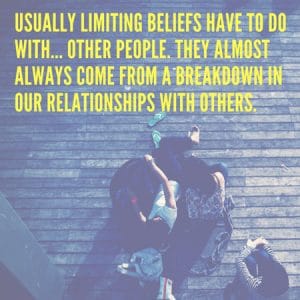 So the majority of limiting beliefs don’t come from times when your life is on the line.
So the majority of limiting beliefs don’t come from times when your life is on the line.
Usually limiting beliefs have to do with…other people. They almost always come from a breakdown in our relationships with others.
In Josh’s example, his limiting belief was a deep fear that people wouldn’t like him.
He wasn’t sure exactly where that fear came from, but it came up every time someone signed up to work with him.
Obviously, if a person feels disappointed in you or doesn’t like you, it doesn’t mean you’re about to die!
So what gives? Why do the brain and body react the same way as if a tiger is chasing you?
People who study the brain think it’s because we need other people to survive.
If you’re a loin-clothed caveman living with a bunch of big animals around you there’s safety in numbers. You have to rely on the community to survive.
Back in the day, if you were cast out of your tribe it would mean certain death.
That’s one of the reasons our brains are hardwired to care about what other people think of us.
It’s also why we have a hard time letting go of criticism and people’s negative judgments of us.
The Emotional brain sees judgment and criticism as a threat we have to deal with right now.
And the only way it knows how to deal with a threat is to mobilize your brain and body to fight, run away, or freeze.
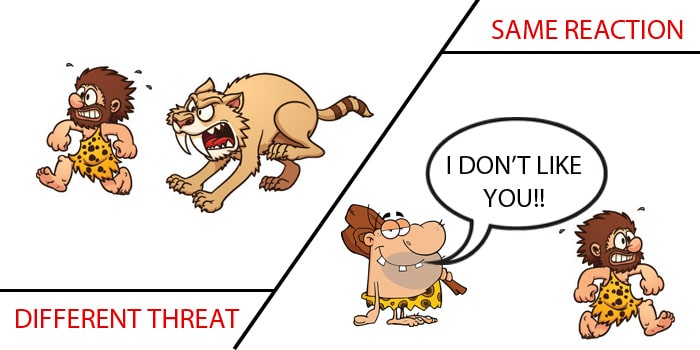 So when you were out in the playground and that big bully made fun of you… or when you weren’t invited to your friend’s birthday party, your brain said, “Ouch! Pain!! Threat!! Deal with it! Red alert! Do something!”
So when you were out in the playground and that big bully made fun of you… or when you weren’t invited to your friend’s birthday party, your brain said, “Ouch! Pain!! Threat!! Deal with it! Red alert! Do something!”
Anytime you feel threatened the threat response in your body gets triggered. It doesn’t matter if the threat is emotional, physical, or social.
The threat response is usually not the best way to deal with “people problems.” Having tense shoulders and a queasy stomach doesn’t help you get along with people any better…
But it’s just the way your brain and body has been wired to deal with danger.
Here’s a really important point to remember:
It’s your Emotional Brain’s INTERPRETATION of something as a threat that makes it a threat.
In other words, it’s the story your brain tells about the event that makes you anxious and afraid.
What if you could change your story?
Then, of course, you would be free.
Brain rule #3: Limiting beliefs are “lessons”, ”decisions”, or ”rules” that the Emotional Brain learned from the past
Remember your Emotional Brain’s #1 job? To keep you safe and alive!
To do that, it tends to judge things quickly and put them into broad categories:
“This is good and that’s bad.”
“This is safe and that’s dangerous.”
“She is being nice and he is being mean.”
Remember, it’s the Rational Brain that likes complexity. It can look at a situation and analyze it to see all the shades of gray. That’s one of the things its really good at.
The Emotional Brain likes simplicity. Its job is to simplify the world into basic stories.
It is a meaning-making machine. It’s constantly evaluating the people and the environment around you, trying to make sense of your world.
If something bad happens to you it tries to explain why it happened.
So how does a limiting belief get created?
- First, you live through some kind of experience that the Emotional Brain sees as a threat.
- The amygdala sounds the alarm inside of your brain and mobilizes your body to deal with the threat.
- After the “threat” is over, your brain stores the “rule”, “lesson”, or “decision” in case you need it again. It also stores how your body felt when you experienced the threat.
Daniel’s fear of the phone
Let’s walk through how this works with a quick story:
Daniel was a real estate developer in the late 2000’s. Business was going great and his empire was quickly expanding. He loved the lavish, comfortable lifestyle that his real estate deals gave him.
Then 2007 came and the whole real estate market crashed.
Almost overnight, he went from earning hundreds of thousands of dollars a year to owing millions to the bank.
He was cash-strapped and desperate, but it didn’t stop the creditors from calling him. He received almost daily phone calls demanding that he pay back his loans.
The phone calls started pouring in from unknown numbers. They got nastier and nastier by the day as the banks tried to squeeze every last penny of what he owed them.
It was a stressful time for Daniel and his family. He felt like he was walking around with knots in his stomach and his anxiety was through the roof.
Of course, the threat response was also activated in his brain during that stressful time. It was trying to help him do something and find a way out.
He discovered a neat trick:
He could avoid all the pain and uncomfortable conversations if he didn’t answer the phone.
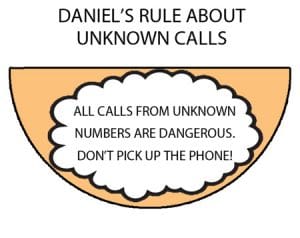 So he ignored every call that came from a number he didn’t recognize.
So he ignored every call that came from a number he didn’t recognize.
You could say that his Emotional Brain created a “rule” about these unknown calls:
Picking up the phone means danger and discomfort!
Fast forward five years later. Daniel had settled all his loans with the banks and found himself back on his feet.
He was still working in the real estate industry, but now as a mortgage lender. The money wasn’t as big, but his business was stable and successful.
But Daniel had a problem…
He still had a hard time picking up the phone when an unknown number called him!
Unlike 5 years before, Daniel knew that these calls were most likely all innocent. He didn’t owe anybody money and there was no reason for anybody to call him and threaten him.
He knew rationally that it was perfectly safe to pick up the phone.
In fact, he knew that a lot of the unknown callers were potential new clients reaching out to him.
He also knew that when he didn’t pick up the phone they probably wouldn’t leave a message. Instead, they would call one of his competitors who WOULD pick up when they called.
His fear of picking up the phone was costing him money, potentially thousands of dollars a year!
He knew all this and yet he still got the same queasy feeling in his stomach when an unknown call came in.
The stress from five years before had caused his Emotional brain to see the world differently.
It had created a powerful rule about picking up the phone:
“All calls from unknown numbers are dangerous. Don’t pick up the phone!”
Just like Daniel, Josh’s anxiety at night came from something in his past.
Let’s look at how Josh’s fear of displeasing his clients was first created:
As you can see from both these stories, every limiting belief comes from the past.
Sometimes, they get created because of an event that happens one time but leaves a scar. For example, when somebody judges us and says something harsh.
Other times, these beliefs are created from bad things that happen to us more than once. Daniel’s story above is an example of this.
Sometimes, we form limiting beliefs by observing our parents or the people around us.
For example, Nita used to watch her mother work so hard around the house and never take a break.
She would see her father come back home after working so hard that he passed out.
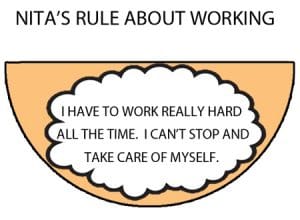 Seeing this pattern over-and-over again shaped how Nita saw the world. Her Emotional Brain created a strong rule:
Seeing this pattern over-and-over again shaped how Nita saw the world. Her Emotional Brain created a strong rule:
“I have to work really hard and work all the time. I can’t take time to stop and relax.”
By the way, this is the rule that plagues “workaholics.”
Anytime she would think about resting or taking it easy, this rule would get activated. It would tell her, “Danger! You can’t rest or relax! It’s not safe!”
Not all limiting beliefs come from the family. We are also powerfully influenced by messages from society all the time.
These messages can sneak into our Emotional Brain and shape our perceptions about our worth and abilities – without us even realizing it.
Here are some examples of limiting beliefs people learn from society:
“Girls are smarter than boys.” (Or vice versa)
“People who are taller/more attractive are more successful.”
“Boys have to be good at sports.”
“Money is the root of all evil.”
Brain rule #4: The Emotional Brain never forgets – it uses your past experience as a guide to keep you safe & alive now
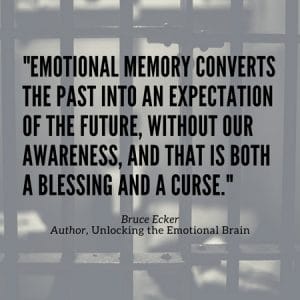 The Emotional Brain is truly incredible in its ability to remember things. This is both a blessing and a curse.
The Emotional Brain is truly incredible in its ability to remember things. This is both a blessing and a curse.
It remembers many wonderful moments in your life… times when you felt a sense of pride or accomplishment. When you felt a strong loving connection with somebody around you.
But it also remembers any experience when you feel angry, fearful, or ashamed. All those times when you felt unsafe, criticized, or attacked in any way.
In fact, it has an AMAZING ability to remember things that hurt you in the past.
It kind of sucks… negative memories get cemented into the the brain. And good stuff that happens just bounces off.
When your Emotional Brain gets reminded of a negative memory, the lesson you learned gets triggered. It says, “Danger! Danger! This bad thing is about to happen again.”
From now on, we’ll call this reminder of the past event the “cue” that triggers the Emotional Brain to react.
The cue can be either an internal cue or external cue.
 Internal cues are internal thoughts & images that remind you of past events.
Internal cues are internal thoughts & images that remind you of past events.
Have you ever gotten lost in your thoughts and all of a sudden you felt like crap?
Something in your train of thought was the cue for you to feel bad.
External cues are about your environment. They are the things you see, hear, observe, taste, smell, etc.
Your Feeling Mind doesn’t analyze all the complexity of the situation to see if it’s the same. That’s what the Rational Brain does.
It doesn’t need for the present situation to be identical to the past.
All it takes is one tiny similarity. A very small connection to the present can bring back the feeling of pain or danger.
The minute your Feeling Mind sees a similarity it says, “This bad thing is going to happen again! Watch out! Danger!”
With Daniel’s fear of picking up the phone, the connection was pretty obvious to him:
Anytime he got a call from an unknown number, his Emotional Brain freaked out: “Danger! Danger!! It’s probably an angry banker on the line!”
Other cues are not as simple.
In Josh’s case, why was his wrestling experience, which had ended 10 years before, causing him problems now? Why was it keeping him from sleeping at night?
Let’s take a closer look…
There are two different kinds of limiting beliefs:
Situational Beliefs and Core Beliefs
Situational beliefs
Limiting beliefs that are “situational” don’t intrude into your daily life. They only show up in specific types of situations.
In Josh’s example, his limiting belief was more of what we call a “situational” belief. It only got triggered in a specific situation when the right cue was present (“Oh no! An opportunity to let them down!”).
In fact, Josh’s sleep challenges didn’t start until years later when he started his own business.
Situational beliefs usually don’t wreak as much havoc on your life as core beliefs.
They are also usually easier to discover because you can start by analyzing the cues:
“Okay, what set me off in this situation? What is it about this situation that makes me afraid or causes me pain?”
Here are some examples of problems caused by situational limiting beliefs:
- Being afraid of sales calls (Call reluctance)
- Procrastinating on a specific activity
- Fear of public speaking
- Feeling afraid of being around your Type A boss
Core beliefs
 Core beliefs are more global and affect many areas of your life. They are the way that you view yourself and the world.
Core beliefs are more global and affect many areas of your life. They are the way that you view yourself and the world.
Core beliefs are usually deeply rooted in your unconscious mind. That makes them tricky to identify and change.
In Nita’s case, her workaholism was because of a powerful core belief:
“I have to work really hard and work all the time. Something bad will happen if I don’t get everything done TODAY.
This belief affected almost every aspect of her life. When she started cleaning the house she couldn’t stop until everything was clean.
In her business, she couldn’t relax if there was work still to be done (and there was always work to be done).
Many nights she worked too late. And worse, she took her anxiety to bed. Of course she slept like crap those nights.
Nita’s rule about work is the perfect example of a core belief.
Core beliefs are so big and global that they get triggered often and tend to bleed over into many areas of your life.
Here are some other examples of problems caused by core beliefs:
- Self-image/self-esteem issues
- Perfectionism
- Chronic procrastination
- General anxiety and social anxiety
Limiting beliefs can be so mysterious and frustrating. That’s because we’re not always aware of what triggers our reactions.
Sometimes, we can find ourselves in the grip of anxiety and fear without realizing how we got there.
The next brain rule explains why…
Brain rule #5: Just like Las Vegas, whatever happens in the Emotional Brain stays in the Emotional Brain (usually).
Unfortunately, most limiting beliefs are subconscious. They are outside your conscious awareness and control.
And that’s what makes them hard to deal with.
Just like with Josh’s sleep problems, we usually don’t even know what the belief is about or why it’s tripping us up.
Imagine a big iceberg in the water.
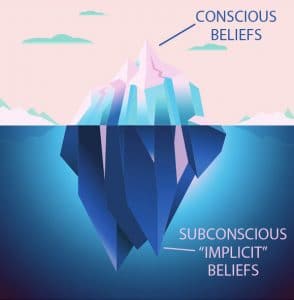 The ice that you can see above the water are the beliefs that you know about. They’re your conscious beliefs.
The ice that you can see above the water are the beliefs that you know about. They’re your conscious beliefs.
For example, you might have a conscious belief like this: “To be successful, I have to work really hard.”
However, most of the feelings and beliefs you have are below the surface of the water. They are in the deep part of the ocean, your subconscious Emotional Brain.
Psychologists call these subconscious beliefs “implicit beliefs.”
They form the iceberg below the surface of the water. They are your thoughts and feelings outside of conscious awareness and control.
Implicit beliefs are stored in a part of the brain where there is no language. That makes figuring them out kind of tricky.
As you saw in rule #3, most limiting beliefs get formed from how you interpret things going on around you.
Usually, we’re not even aware when a negative story gets created. But these subconscious stories can control our life.
For example, Nita learned to be a workaholic from watching both of her parents.
Neither one of them told her, “You have to work all the time! Don’t ever stop to take care of yourself.” She just saw them do exactly that day after day.
So her young, impressionable Emotional Brain came to the conclusion, “Oh, that’s how I have to be.”
She never had a chance to decide for herself.
Also, our Rational Brain helps us analyze an idea and decide if we want to believe it or not.
But it doesn’t come fully online until we’re 25. By that age our programming is pretty much set.
That’s another reason why Nita ‘s belief was unconscious. It slipped into her Feeling Mind before she had a chance to reject it.
This is the biggest problem with limiting beliefs:
To change a limiting belief, you have to “shine a light” on it and see it for what it really is.
But most limiting beliefs are subconscious, so how do we figure them out?
Fortunately, there lots of tools for discovering your limiting beliefs.
We’ll share two of the simplest techniques in part 2 of this guide.
Brain Rule #6: To overcome your limiting beliefs, you have to update your IOS (Incomplete, Outdated Stories)
Remember how Daniel first started avoiding calls from unknown numbers?
Ignoring unknown calls was a great strategy when he first started doing it. It helped him avoid uncomfortable, awkward conversations. It kept him away from pain.
In other words, it was the right thing to do at the time.
The problem was that his situation was very different five years later. He was out of debt and in a completely new occupation.
The people calling him weren’t angry creditors looking for their money. They were clients looking to give him some of their money!
But his Emotional Brain still convinced him it was safer to avoid those calls.
That’s what often happens with limiting beliefs. They’re usually formed as an attempt to protect us in some way.
Then we move through life and “outgrow” those bad experiences… we escape our negative families, we move away from the bully, our situation changes for the better, etc.
But the story doesn’t change to match our new life experience!
In other words, the negative story can easily get “stuck” or “trapped” deep in your mind.
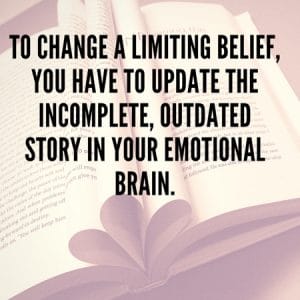 Remember: Your Emotional Brain’s number one job is to help you survive.
Remember: Your Emotional Brain’s number one job is to help you survive.
Period.
End of story.
That’s why your mind has a hard time letting go of these old stories-they feel important to your survival.
Many limiting beliefs start out as a rule that was “adaptive”- they truly did help you get through that tough time.
But most of them aren’t true or helpful anymore. They’re outdated stories.
Daniel’s story that unknown calls were angry creditors was no longer true. In fact, it was costing him a lot of money!
Also, many limiting beliefs are based on incomplete, inaccurate information.
In Josh’s case, nobody ever told him, “I hate you and you let me down!”
Not even close!
And yet, that’s still what Josh believed about his coaches.
Now, he didn’t come to that conclusion randomly. His Emotional Brain followed a certain logic to create that belief:
- His coaches had great expectations of him before the season. (They told him that.)
- He got hurt and he wasn’t able to fulfill those expectations.
- So they must hate him and feel like he let them down.
This story felt deeply true to Josh. He felt certain that his coaches really did hate him and felt disappointed in him.
But this belief was formed using “incomplete information.” It didn’t take into account how his coaches’ actually acted around him.
As you’ll see in Part Two, there’s almost always evidence that can disprove your limiting belief.
Recapping the brain rules:
Before we go into steps of limiting beliefs and how to change them, let’s recap what we know so far about them.
Limiting beliefs usually are a reminder of some pain in the past. Or they’re an attempt to protect you from past pain.
When a limiting belief comes up, it triggers the threat response in your brain and body. That’s why you feel uncomfortable in your body.
These beliefs get triggered when you Emotional Brain sees a connection to a past painful experience.
Sometimes the connection is so small that it doesn’t make much sense.
Most limiting beliefs are subconscious. They fly under our radar. They’re like invisible anchors holding us down.
And finally, to overcome a limiting belief, you have to update the story that keeps you stuck.
Be sure to check out part two of this Beginner’s Guide below.
Part 2: Overcoming Your Limiting Beliefs in 3 Simple Steps
Congrats!
If you’ve made it this far, you know a lot more than the average person about limiting beliefs and the brain.
Now it’s time to learn the steps to change your limiting beliefs once and for all.
But before we do that, let’s recap what you know so far:
You know that you have two different “brain systems”- the Rational Brain and the Emotional Brain.
 You know that you create and store limiting beliefs in your Emotional Brain.
You know that you create and store limiting beliefs in your Emotional Brain.
You have to re-program your Emotional Brain to overcome your limiting beliefs… or they’ll continue to haunt you.
Your limiting beliefs trigger the threat response in your body. So you have to convince your Feeling Mind that it’s not in any danger anymore and that the situation is different.
Every limiting belief has a specific set of cues that can cause the threat response to get triggered.
This is how that happens:
Something in the present reminds you of a painful event in the past. That brings up the “rule” or “lesson” that you learned from that experience.
These cues are sometimes mysterious to us, so you may think your limiting belief is “irrational.”
But your limiting beliefs always make sense to the Emotional Brain. They fit some aspect of your past.
And finally, you know that every limiting belief is an outdated, incomplete story.
If you want to change the limiting belief, you have to change the story.
Alright, now that quick review is done… you’re ready to learn the steps for transforming your limiting beliefs.
The Science of Changing Limiting Beliefs
This is such an exciting time to be alive!
Psychologists used to think that it was impossible to get rid of limiting beliefs.
In other words, in “ye olden days” once a limiting belief got “installed” in your mind, you were stuck with it for life.
Now we know better!
The brain can change at any stage of life. No matter how long you’ve lived with a limiting belief, you can still overcome it.
New research on a process called “memory reconsolidation” has given us the keys to the kingdom. This research shows that you can experience deep, life-long change in a very short period of time.
Memory reconsolidation just means “deleting an old memory and re-writing it with something new.”
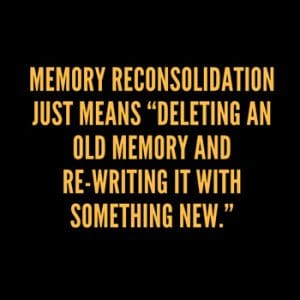 In reality, you’re not deleting the memory itself. You’re just deleting the limiting story that got attached to that memory so you can free yourself from it.
In reality, you’re not deleting the memory itself. You’re just deleting the limiting story that got attached to that memory so you can free yourself from it.
You can overcome any limiting belief… if you know how to do it!
The steps below are what your Emotional Brain needs to delete and re-write an old memory.
Here are the three steps to changing limiting beliefs:
Step 1: Identify the limiting belief
Step 2: Find an experiences that “disproves” the limiting belief
Step 3: Dissolve and re-write your limiting belief
An overview of the steps for overcoming limiting beliefs
Overcoming limiting beliefs – Step 1:
Identify the Limiting Belief (Put a name on the sucker)
 This step is very simple to understand: Your goal is to identify the limiting belief and put words to it.
This step is very simple to understand: Your goal is to identify the limiting belief and put words to it.
Even though it’s simple to understand, it’s one of those things that’s “easier said than done.”
As you saw in Part 1, discovering the root cause of a limiting belief can be tricky.
That’s because most of your beliefs are subconscious and out of your everyday awareness.
You’re trying to put words to your belief so you can become aware of it. You’re trying to move it from the subconscious Feeling Mind up to the conscious Thinking Mind.
You’re not doing it to re-experience the pain all over again. You’re doing it so you can overcome it.
The research shows that even naming your limiting belief helps weaken it.
By the end of Step 1, you should have a complete sentence written out that describes the limiting belief.
What you’re looking for is the “emotional truth” of the belief. You want to understand the story that FEELS true to your Emotional Brain.
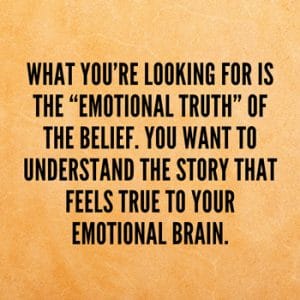 NOTE: If you have a history of any kind of trauma, DON’T try to change your limiting beliefs on your own.
NOTE: If you have a history of any kind of trauma, DON’T try to change your limiting beliefs on your own.
Trauma is any experience that is “too big or overwhelming” to bear. So any type of sexual abuse, childhood abuse, death of a loved one or friend, near death experiences, etc.
You can open up a huge can of worms if you try to heal your trauma on your own. You can re-experience the trauma and put yourself through a lot of unnecessary suffering.
Please seek out the help of a trained mental health professional specializing in trauma. They can help you resolve it safely and with minimal pain.
Here are some tips for wording your limiting belief:
Tip #1: Use the strongest language you can.
The Emotional Brain is much simpler in how it views world than the Rational Brain. It doesn’t beat around the bush.
So when you’re putting words to your limiting belief, don’t try to pretend like it’s not that big a deal. Don’t try to rationalize, sugarcoat, or diminish it in any way.
Remember Josh’s wrestling story?
Notice that Josh didn’t say, “My coaches were kind of a little disappointed that I wasn’t more successful.”
His limiting belief was “I let them down and they hate me.”
Use the strongest language possible while still being true to the feeling.
Tip #2: Always put the sentence in the present tense.
It’s important to always write your statement in present tense.
That’s because your Feeling Mind is always in the present. It doesn’t really have a sense of time.
Your Rational Brain gets time. It knows whether something you’re thinking about is in the past, present, or future.
But your Feeling Mind is always in the present. When it feels an emotion, it experiences it like it’s happening RIGHT NOW.
So even if the experience happened 50 years ago, put your statement in the present tense.
Two simple techniques for discovery: Sentence Completion and Bridge to the Past
Luckily, there are lots of techniques for discovering your limiting beliefs.
So you don’t have to be stuck guessing what’s bothering you.
In this Beginners’ Guide, we’re going to share two simple techniques:
- Sentence Completion
- Bridge to the Past
Sentence completion
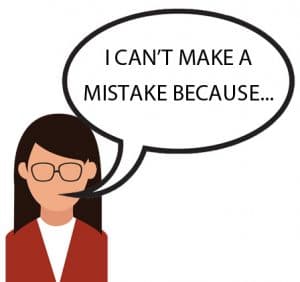 Sentence Completion is one of the simplest techniques for discovering your limiting beliefs.
Sentence Completion is one of the simplest techniques for discovering your limiting beliefs.
But don’t let its simplicity fool you! It’s easy to use, but very powerful.
All you have to do is come up with the start of a sentence. Then fill in the blanks with whatever comes into your head.
You’re just finishing a sentence to see what words pop up.
It’s a sneaky way of getting your Feeling Mind to reveal how it really feels.
This technique works so well because your subconscious mind can’t resist the temptation to finish the sentence.
Here’s a few sentence fragments to get you started:
I CAN’T…
Use this sentence to figure out what you’re Emotional Brain is afraid will happen if you do something.
Ex. “I can’t pick up the phone when I don’t recognize the number because…”
IF THIS HAPPENS, THEN…
This is similar to the “I can’t” sentence above. You just create a quick If/Then sentence that describes your fear.
Ex. “If I make a mistake, they’ll laugh at me and think I’m stupid.”
THAT MEANS…
This is a great sentence to use if you know which past event might be behind the limiting belief… but you don’t know how your Emotional Brain interpreted this event.
Just tell the fact of what happened and finish the sentence with: “And that means…”
Ex. “I got fired from my job, and that means… they don’t see my value.”
“My boyfriend dumped me and that means… I can never love someone again.”
Two tips for using Sentence Completion:
Tip #1: Keep it Simple
Make sure you use very simple sentence patterns like the examples above.
You’re not looking to write a novel about how you feel. You’re just trying to find the belief that represents how your Emotional Brain REALLY feels.
If you create a long, complex sentence you’ll give your Feeling Mind too much to think about.
Here’s the rule of thumb with Sentence Completion:
The simpler the sentence, the better the results you’ll get.
Tip #2: Repeat the sentence at least 3 times
Say the sentence out loud at least 3-5 times.
Usually, the first couple of answers are the most obvious. But they may not be the emotional truth.
Keep finishing the sentence until you hit on words that feel true. You’ll know because you’ll feel a surge of emotion inside your body.
Let’s look at how Daniel used sentence completion:
“If I pick up the phone with an unknown caller, I won’t know what to say.”
“If I pick up the phone with an unknown caller, I’ll have an unpleasant conversation.“
“If I pick up the phone with an unknown caller, they’ll be angry with me and threaten me.“
This last statement felt true to him. He finally hit on the belief that was making him so uncomfortable.
Let’s take a look at how Josh used sentence completion to discover his limiting belief
Bridge to the Past Technique
This technique is a little trickier to pull off because it takes some self-awareness. But it can give you amazing insight into your limiting belief.
The goal is to get in touch with how your body feels first. That’s because your feelings always show up in your body. Feelings are the language of the body.
It’s hard to figure out your limiting belief by trying to think your way there.
With this technique, your body will give you the clue to your limiting belief.
Here are the steps:
Step 1. Do a body scan
The first step is simple. Take in a few deep breaths. Then scan your body for any tension or pain.
Describe how your body feels.
“It feels like a fist gripping my chest.”
“My neck is stiff as a board.”
Step 2. Tap into images, thoughts, and feelings
Notice what words, thoughts, or images come to mind as you focus on the tension in your body.
“The words ‘you’re not good enough’ popped into my head.”
“I can see my father’s angry face.”
“I’m scared and feel like all hell is breaking loose.”
Step 3. Ask the “bridge” question
Ask the “bridge” question to understand the connection the past.
Bridge question:
What does this feeling or image remind you of from your past? Is there anything familiar about it?
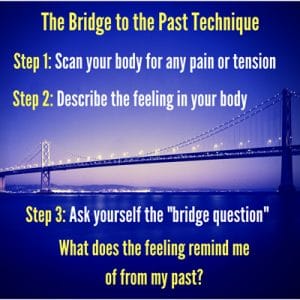 Notice anything that comes up when you ask yourself that question.
Notice anything that comes up when you ask yourself that question.
You may have an image flash through your mind of some painful event in the past.
Or you may remember something your father or mother said to you once that stuck in your Emotional Brain.
Once you’ve connected with the event, see if you can discover the “lesson” or “rule” you learned about the event. (See part one of this guide for more info on lessons and rules.)
We’ve used this technique on ourselves and with our clients. You can learn amazing answers from your body.
Sometimes, the limiting belief is completely different than what you thought!
The Bridge to the Past technique is a great way of finding the truth.
Using both Sentence Completion and Bridge to the Past together
You can even use these two techniques together to discover the limiting belief.
If you’re not even sure what the limiting belief is about, start with the Bridge to the Past tool. You can use that to discover the event or root cause that created the belief.
For example, you may notice some anxiety in the pit of your stomach.
Ask your body, “What does this remind me of?”
An image of your father yelling at you for making a mistake as a child flashes into your head.
Then you can use Sentence Completion to discover the story that got attached to the event.
For example:
“My father is really angry at me for screwing up, and that means…”
“That means it’s not safe to make a mistake.”
“That means I am careless.”
“That means I have to be perfect or else.”
Keep finishing the sentence until you discover the “emotional truth” about the event.
REMEMBER:
The goal of Step 1 is simple.
At the end of step 1, you should have a sentence that accurately reflects your limiting belief.
This sentence sentence should describe how you REALLY feel deep down.
Overcoming limiting beliefs – Step 2:
Find an experience that “disproves” the limiting belief
When a limiting belief gets triggered, your brain sees something in the present as a threat.
The goal of this step is to get your Emotional Brain to see the situation differently. You’re trying to change the story and remove the threat.
You want your Feeling Mind to say, “Huh, it’s not like that. I can calm down now. There’s no danger!”
To do this, you need to FIND or CREATE an experience that updates or completely disproves your belief.
This is important: You need an EXPERIENCE that disproves it, NOT a bunch of reason, data, statistics, etc.
This is where most approaches to overcoming limiting beliefs fail. They try to use reason and logic to change the Feeling Mind.
It’s why people spend years in “talk therapy” and don’t make much progress. They’re only changing their thoughts on the surface, in their Rational Brain.
They’re not changing the story deep in the Emotional Brain. And the Feeling Mind doesn’t respond to logic and rationality.
As you saw in Part 1 of this guide, your limiting belief was created in response to a negative EXPERIENCE.
To “uncreate” it, you have to tap into a positive experience.
Three Ways to Overcome Your Limiting Belief
We’ll show you three different ways you overcome your limiting belief:
- Revise the story with new information
- Disprove it completely
- Update the story to make it reflect present reality
1. Revising the old story with new information
This is a good approach to use with many childhood limiting beliefs.
We all have had things happen to us in our childhood that were less than ideal. Your parents got angry at you. Maybe they shouted at you.
You may have felt left out or excluded from a group. A kid (or adult) may have acted out of their own pain and tried to bully you.
You can’t go back and change those events to prevent them from happening.
But you can revise the story now so they no longer keep you stuck.
Nita’s father yelled at her when she was a child.
A lot.
When she was small, she didn’t understand her father’s anger issues. She thought it was her fault that he was angry.
Now she has revised the story she has about him:
“Yeah, he was angry at me, but it’s only because he had big anger issues. It’s not my fault. I’m not responsible.”
Revise the story by bringing in information that you hadn’t considered when you formed the limiting belief.
It’s all about telling a more truthful, complete picture of what happened… so your Emotional Brain can let go of the limiting story.
2. Completely disproving the old story
 “It just didn’t even happen like that. That’s not the truth.”
“It just didn’t even happen like that. That’s not the truth.”
This is the most powerful way to overcome a limiting belief.
This approach works well for a lot of limiting beliefs. It’s especially powerful for strong limiting beliefs about self-esteem or self-image.
For this approach to work, you have to prove that your Emotional Brain is believing a lie.
But again, NOT proof using reason, logic, numbers or anything like that.
Basically, you’re trying to help your Emotional Brain realize, “Oh my gosh! That’s not even true!”
To find an experience, ask your yourself:
“What have I experienced that is different than this limiting belief? Or that disproves it completely?”
Let’s look at how Josh disproved his belief about his coaches hating him:
3. Update the story to make it reflect present reality
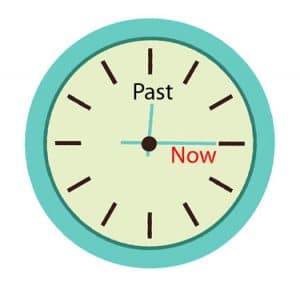 “This bad experience is over and in the past. It’s not true anymore.”
“This bad experience is over and in the past. It’s not true anymore.”
This approach is great for limiting beliefs when the threat or pain is over and in the past.
For times when your current reality is truly different than what it used to be… And your Emotional Brain is stuck holding onto the old story.
Find an experience or feeling in your now that is the opposite of your limiting belief.
This is the approach we took to help Daniel overcome his limiting belief:
“All calls from unknown numbers are dangerous. Don’t pick up the phone.”
We’ll share that story later in a video later on.
Overcoming limiting beliefs – Step 3:
Dissolve and re-write your limiting belief
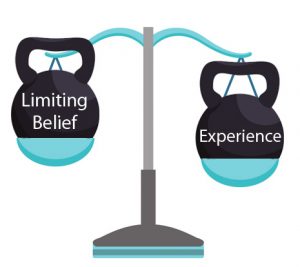 Step 3 is all about overcoming your limiting beliefs.
Step 3 is all about overcoming your limiting beliefs.
In this step, you’re going to dissolve your limiting belief by using the experience you identified in step 2.
In Step 1, you discovered what the limiting belief is about.
Then in Step 2 you found an experience or feeling you could use to delete that belief.
Now in Step 3 you’re going to get in touch with how both experiences feel… until your Emotional Brain gives up the limiting belief.
There’s three basic tools we want to share with you in this beginner’s guide for doing this.
Start by using Tool 1 first, then Tool 2, then Tool 3 if those two don’t work.
NOTE: There are some advanced brain tools that can help calm down the Threat Response. These tools make overcoming limiting beliefs much faster and more effective.
We teach people how to use them in our program Tools for Transformation.
Tool 1: Write down your limiting belief & speak it out loud as if it’s the truth
If you’ve done Step 1 well and you have the wording right, then this part is easy.
The easiest way to shift a limiting belief is to say it out loud.
Often saying it out loud is enough to disprove it. That’s because your mind will start looking for information or experiences that don’t match it.
Speaking your limiting belief out loud activates your brain’s “mismatch detectors.”
Notice what comes up when you say it out loud. Notice if your brain already starts looking for evidence to disprove it.
We’ve seen lots of people shift their belief just by saying it out loud. Give it a try yourself.
Tool 2: Write down your limiting belief and the new experience that disproves it
 If you don’t start feeling a shift after you say it out loud, give this technique a try.
If you don’t start feeling a shift after you say it out loud, give this technique a try.
This is where you write down your limiting belief first… then write down your “mismatch” experience right next to it.
Try to imagine the feelings of both.
So in Josh’s case, he wrote down the idea “I let them down and they hate me.”
Then he remembered his coach openly praising him to the whole team, telling them how proud he was.
He thought to himself, “How could they hate me and praise me at the same time..?”
And he felt his feeling shift and the anxiety and tension calm down in his body.
He also remembered that his coaches gave him the Coaches Choice award at the end of the year. They were honoring his persistence and tenacity.
After all, he had continued wrestling even after experiencing a very traumatic injury.
While he was thinking of these experiences, he had a huge realization:
“They weren’t disappointed IN me, they were disappointed FOR me.”
They felt disappointed that he had tried so hard and then got hurt at the last minute.
Now give it a try!
Remember, your options are to:
- Revise the old story in some way with new information that your Emotional Brain left out
- Find an experience that completely contradicts the event
- Convince your Emotional Brain that the experience is over & no longer true
If the feeling doesn’t shift after your first try, write down the statement on a card. Read it once or twice a day.
Josh’s card would have sounded like this:
“I feel like I let down my coaches and they hate me. But they also praised me in front of the whole team and gave me the Coaches Choice award.”
Tool 3: Create an imagined experience that “disproves” your limiting belief
 This technique is the hardest to do. It’s a pretty advanced technique, so we won’t explain it in great detail.
This technique is the hardest to do. It’s a pretty advanced technique, so we won’t explain it in great detail.
Usually you need a trained coach to help you with it because it’s difficult to do on your own.
With this technique, you’re tapping into a unique fact about your Emotional Brain:
It can’t tell the difference between something that’s real and something you imagine.
This is how we helped Daniel overcome his fear of answering unknown calls.
Test your limiting belief
This last part of the step is simple. You want to confirm that you have shifted your limiting belief.
Here’s one simple way to tell: Speak your limiting belief out again.
Notice how you feel when you say it. See if it feels true to you still.
If you don’t feel anything when you say it, there’s a good chance you’ve overcome your limiting belief.
The true test is to put yourself back in the situation that usually triggers the limiting belief. See if it flares up again or if you’ve overcome it for good.
Sometimes there are different “layers” with limiting beliefs.
You can resolve one layer only to discover that there’s something deeper that needs to be dealt with.
Just follow the same processes we’ve taught you and you’ll be on the right path!

